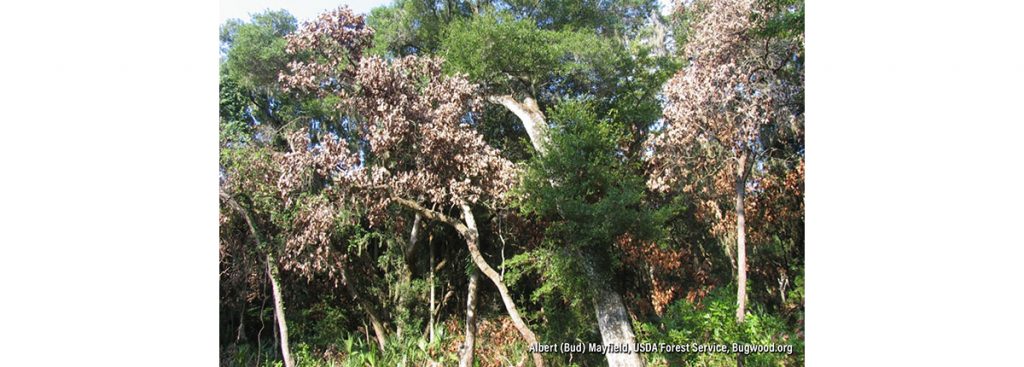
The N.C. Forest Service (NCFS) has confirmed that laurel wilt, a devastating disease of redbay and other plants in the laurel family, has been identified on private land along U.S. Route 258 in Jones County. Sassafras, redbay, swampbay, pondberry, pondspice and spicebush are in the laurel family and can be affected by this disease.
“Laurel wilt is easier to spot during winter months when the rest of the trees do not have leaves,” said Jim Moeller, forest health specialist. “We were able to make this detection during a routine laurel wilt survey.”
The fungus that causes laurel wilt is introduced into trees by the nonnative redbay ambrosia beetle. Native to southeastern Asia, the beetle was first detected in the U.S. near Savannah, Ga. in the early 2000s. It has since spread to 11 additional states, from Texas to North Carolina. It is believed the pest can travel about 20 miles per year naturally but can spread more quickly when the fungus-carrying beetles are transported in wood such as firewood, Moeller said.
Female redbay ambrosia beetles bore into trees, carrying the fungus with them. Once the beetle is inside the tree, she makes tunnels and lays eggs. Fungal spores begin to grow in these tunnels, blocking the movement of water from the tree roots and causing the tree to wilt and eventually die from lack of water. This fungus is extremely fast-acting, and trees typically die within a month of infection. Beetles do not feed on the wood of the tree; rather, they feed on the fungus “farm” they created, he said.
Symptoms of laurel wilt disease include drooping reddish or purplish foliage. Evidence of a redbay ambrosia beetle attack may be found in the main stem; often strings of chewed wood, called frass toothpicks, can be seen sticking out of entry holes. Removal of tree bark reveals black streaking in the outer wood.
Currently, there isn’t a reliable way to prevent or treat laurel wilt. Insecticides have not been effective in stopping beetle attacks, and fungicides are costly and need reapplication. “Our best weapon is to slow the spread, and you can help by using local or treated firewood and by notifying your NCFS county ranger if you suspect laurel wilt has invaded a new area,” Moeller said.
Homeowners with dead redbay trees are encouraged to keep cut trees on their property. Dead trees should not be removed to a landfill or off-site. Proper disposal of redbay trees includes leaving wood on-site, cutting or chipping wood on-site, or burning wood on-site in compliance with local and state ordinances. You can obtain a burn permit at any authorized permitting agent or online at ncforestservice.gov/burnpermit.
The detection of laurel wilt in Jones County was confirmed by pathologists at N.C. State University’s Plant Disease and Insect Clinic. To learn more about laurel wilt, visit ncforestservice.gov/
and follow the links under the Forest Health section, or call your NCFS county ranger. To find contact information for your local NCFS county ranger, visit https://www.ncforestservice.gov/contacts
A map showing laurel wilt detections throughout North Carolina is available here.
By Randy Foster

